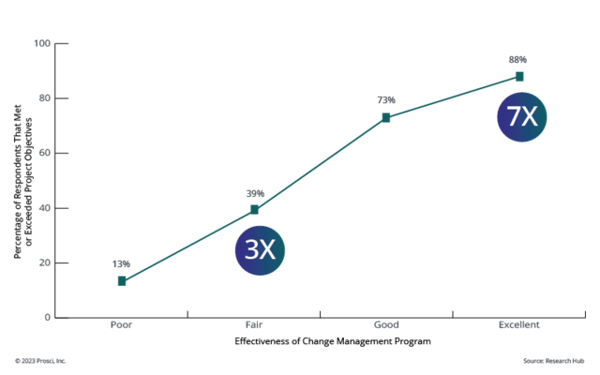Supporting Project Results With eLearning

3 Mins
Updated: December 11, 2023
Published: November 7, 2018

Over 25 years of research consistently support our finding that projects with excellent change management are seven times more likely to achieve results as projects with poor change management. Engaging people in the people side of a change project also makes it more likely that the project will be delivered on time and on budget.
However, I also like to point out to people that even moving from “poor” to “fair” change management increases the likelihood of achieving outcomes by nearly 3X. That means that doing the best with the time, resources and capacity you have can have a meaningful impact.
The question then becomes, “How do you drive more quality change management when you are low on time or resources?”

Prosci’s research has identified seven top contributors to change success. The bolded contributors show that change success depends largely on people, and especially a diversity of roles within the organization:
- Active and visible sponsorship
- Structured change management approach
- Dedicated change management resources
- Integration and engagement with project management
- Employee engagement and participation
- Frequent and open communication
- Engagement with middle managers
Having dedicated change management resources is essential to change success. Yet this research highlights that being able to drive adoption and usage, which leads to achieving project outcomes, requires more than just a change practitioner. Change management requires many other people to engage and fulfill their roles in the change process. When you’re strapped for time and resources, how can you still engage these roles in a meaningful way?
 Engaging the Many Roles in Change
Engaging the Many Roles in Change
Asynchronous virtual training can help engage the many roles needed for change and bridge the gap until in-person training (which is obviously the ideal situation) is an option. You can use Prosci eLearning to activate the system that brings change to life in the organization. eLearning is an on-demand, just-in-time, turnkey solution that supports project results, especially when there is urgency around a change initiative.
All of Prosci’s eLearning modules ask the participant to select a specific change to apply their learning to throughout the module. When you deploy eLearning in line with a specific project, you engage the project team, managers and employees with content that is specific to their role, but all are still focused on the same change. Also, each module includes a section on the Prosci ADKAR Model, which can help create a common language for everyone to use as they discuss the people side of change related to the project.
Project team and resources
For example, you might ask the entire project team to work through the Introduction to Change Management module. This module will provide everyone associated with the project a common understanding of what change management is and how it supports delivering project results on that specific change.
As a part of the module, everyone will evaluate the project’s health using the Prosci PCT™ Assessment that is embedded in the module. This primes everyone for a productive discussion about the holistic health of the project, the value of change management, and how to most successfully integrate project management and change management.
People managers
Then, you might ask the managers whose teams are impacted by the change to go through the Introduction to Leading Change module and reflect on the specific changes being driven by the project. This gives managers an opportunity to reflect on their role as both an impacted employee of the change and a leader of the change. They will have a chance to identify their own barrier points to the change so they can ask for what they need in order to overcome those barriers and fulfill their role as a leader of change.
Impacted employees
After managers have had exposure to the content, you might have all impacted employees go through the Thriving through Change module, again asking them to reflect on this specific project. These employees will reflect on their emotional reactions to change and where they are in their own change process. This sets up employees to have a productive, action-oriented conversation with their manager about change. Because both people will have had exposure to change management content, they will be able to speak the same language.
Anyone connected to the change
There may be people who don’t fit into the above roles but need to understand the fundamental concepts of change in order to support the project’s results. These may be other key leaders or managers in the organization, advisors or vendors. You can use the Introduction to ADKAR module to give anyone connected to the project a common language for change. Then, when the term “change” comes up, everyone is referring to how to drive the individual change milestones of awareness, desire, knowledge, ability and reinforcement.
Achieve Better Outcomes From Change
When you deploy Prosci eLearning in alignment with a specific project, you have the opportunity to create clarity and energy for that change. With everyone reflecting on the same change during their eLearning experience, you can prime people for further discussion and engagement in the project. This allows you, as a change practitioner, to maximize the face-to-face time you have. By elevating your change management environment and engaging more resources in your change initiatives through eLearning, you can achieve better project outcomes while building change competency in your organization.

